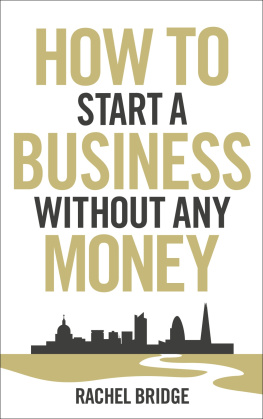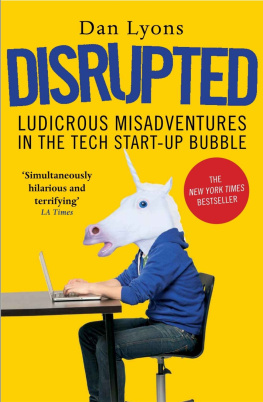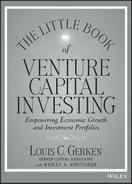
THE FREE PRESS
A Division of Simon & Schuster Inc.
1230 Avenue of the Americas
New York, NY 10020
Visit us on the World Wide Web:
http://www.SimonSays.com
Copyright 1997, 2000 by John L. Nesheim
All rights reserved, including the right of reproduction in whole or in part in any form.
First Free Press Edition 2000
Originally published in 1997 by John L. Nesheim
The Free Press and colophon are trademarks of Simon & Schuster Inc.
ISBN-10: 0-7432-0335-6
ISBN-13: 978-0-7432-0335-7
Contents
Introduction to Start-Ups and Their Funding
Historical Overview
The Process of Forming the Company
Getting Started Legally
Preparing the Business Plan
The Team
Ownership, Dilution, Negotiation, and Valuation
Personal Rewards and Costs
Venture Capitalists
Leasing as a Source of Capital
Bankers and Bootstraps as Funding Sources
Angels and Other Sources of Venture Capital
Wall Street and the Initial Public Offering
Mergers, Spinouts, and Corporate Venture Capital
Appendixes
Saratoga Venture Tables
Resources for the Entrepreneur
Three Venture Capital Firms Describe Themselves
Preface
W hy bother trying to help more entrepreneurs succeed? Start by listening to an icon of venture funding, Don Valentine, founder of Sequoia Capital (that funded Apple, Cisco, Yahoo, MP3.com and more):
Sequoia is focused on the concept of bigness: big thinkers, big markets, big companies. Employing thousands of people paying millions in taxes and hundreds of millions in salaries. Thats bigger than people who just want to become millionaires.
Too many new businesses fail to become successful, including high-tech start-ups. If we could improve the proportion of successes, the economic benefits to nations stagger the mind.
In The Winning Performance, which reported the results of research on 525 of Americas midsize companies, Clifford and Cavanaugh (1985) say that If just 1% of the companies in existence today had had the will and the skill to reach midsize$ 25 million in salesthe American economy would be more than double its current size. Yet the fact remains that more than 999 of every 1,000 companies stay small.
Peter Drucker, in his book Innovation and Entrepreneurship, reported that America created 40 million new jobs over twenty years since 1970. The jobs came from small and new enterprises.
Professor David BenDaniel, professor of entrepreneurship at Cornell Universitys Johnson Graduate School of Management, explains how the world has been impacted by high-tech start-ups:
High-growth ventures have emerged as economic power houses in the United States, generating thousands of jobs, diffusing technological knowledge, and creating a culture of innovation that has ripple effects through out every type of business organization, and indeed their impact has changed business around the world.
The typical venture-backed high-tech start-up has a 60 percent likelihood of going bankrupt. What are the areas in which start-ups need help, and what are the payoffs for helping them?
- High cost of capital. Venture capital investors take high risks and require high compensation. Most founders have little idea how to value their start-ups and how to negotiate with suppliers of capital.
- Increased competition between more numerous, similar start-ups. Large influxes of billions of dollars to venture capital pools have increased competition between start-ups in any given business sector.
- Big companies react more quickly. In response to changes in market conditions, the billion-dollar companies detect and act on business opportunities faster than they used to.
This book is intended to help the leader of a high-tech start-up improve his or her odds of success. It also aims to help the corporate venture capitalist evaluate start-up candidates for acquisition, as well as the new internal start-ups that are emerging. We will analyze successful and unsuccessful high-tech start-ups and the techniques their management use to start, finance, value, and launch a new business from seed financing through initial public offering. We will provide data on the financial rewards of equity ownership and dilution by venture capitalists of famous high-tech start-ups.
This book has six goals:
- To prepare the CEO for the surprises yet to come.
- To prepare the CEO for negotiations.
- To make clear the personal cost of leading a start-up.
- To improve the CEOs odds of success.
- To assist corporate development managers work with new ventures.
- To help new venture capitalist partners and associates get off to a running start.
Conventions and Practices Used in This Book
Most case studies use disguised names. Each case is based on actual events. Research for this book was conducted regularly since 1984, during which more than 300 interviews were done with over 200 individuals in more than 150 companies in the United States and abroad.
1
Introduction to Start-Ups
and Their Funding
T he research on which this book is based provided a lot of data about startups of all kinds that use technology, from semiconductors to Internet sites. The findings include their probability of success and how they are typically organized. Lets begin with thirty-one facts about typical high-tech start-upsmany of them contrary to popular stereotypes.
- The chances are 6 in a million that an idea for a high-tech business eventually becomes a successful company that goes public.
- Fewer than 20 percent of the funded start-ups go public.
- Founder CEOs own less than 4 percent of their high-tech companies after the initial public offering. Boom periods like the early Internet years often raise that to 10% and higher.
- Founder CEOs can expect their stock to be worth about $6.5 million if the company succeeds in going public. Boom periods like the early Internet years produce billionaires.
- Successful venture capitalists expect to personally earn about $7 million (in addition to cash wages) over five years for each $50 million pool of capital they share in managing.
- Business plans are typically poor and are not well received by venture capitalists.
- Unfair advantage and sustainable competitive advantage are missing in most business plans but are considered by investors to be critical if the high-tech start-up is to have an acceptable chance of succeeding. Plans lacking such an advantage rarely receive venture funding from experienced, successful venture capitalists.
- On the average, a venture capitalist finances only 6 out of every 1,000 business plans received each year.
- Venture capital investors own a large 70 percent of the start-up by the time it goes public: 70 percent of hardware companies, 60% of software companies and 50% of Internet companies.
- The personal costs of doing a start-up are high, affecting families and friends as well as individuals. Fear and burnout are common. However, many CEOs have balanced those costs with the rewards of personal and professional satisfaction and the potential financial paybacks, which can be more gratifying than the rewards of working for a large corporation.
- Bankruptcies occur for 60 percent of the high-tech companies that succeed in getting venture capital.
- Mergers or liquidations occur in 30 percent of start-up companies.
- A vice presidents stock is worth about $2.5 million or one third of what the CEO is worth at the time of the initial public offering. Boom periods can increase the wealth tenfold.











